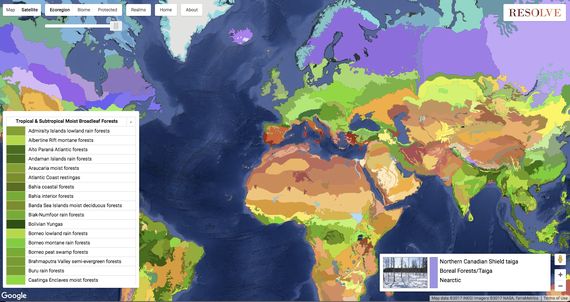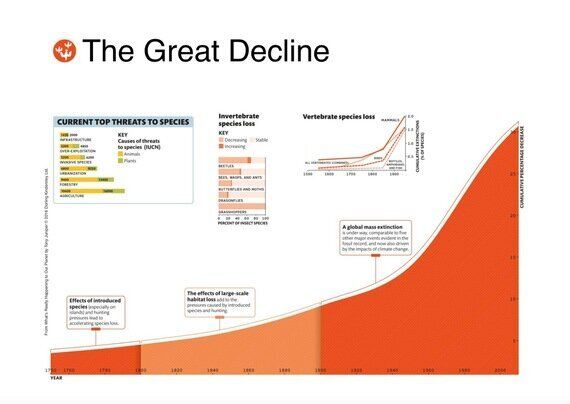
In protecting half the Earth a good place to start is with the 846 terrrestrial ecoregions
A research paper published last week sets out the huge task that lies ahead in reaching the goal of protecting half the Earth. The conclusion that we need to do this to save most of life on Earth comes from one of the world's greatest scientists: the ecologist Edward Wilson (often know as E.O. Wilson). I recently had the pleasure to meet him and to discuss various conservation and ecological subjects, including the future of life on Earth and how, if we wished to conserve most of it, his finding that we'd need to set aside half the planet to do so.
The reason we must contemplate such a step is simple enough: it's because the Earth is in the midst of an accelerating extinction crisis. Caused by the loss and degradation of natural ecosystems, the effects of alien invasive species, pollution and climate change, we are on course by end of this century to lose as much as half the Earth's biological diversity. If that happens not only would critical ecological processes be disrupted but hundreds of millions of years of irreplaceable evolutionary refinement would be lost as well.

The accelerating rate of species loss - image from What's really happening to our planet? Tony Juniper
We know what is needed to avoid this disastrous loss of diversity, including the protection and restoration of natural areas, and I was struck by how like so many other great ideas that the proposal to protect half the Earth was simple to convey while at the same time backed by a vast body of data. Professor Wilson explained how he'd made the case for the idea in his most recent book, Half Earth. He pointed out how if we did succeed in conserving half of the planet's original natural ecosystems, this would result in conserving between 80 and 85% of species.
He'd reached this conclusion, based on years of insight, including that arising from his trailblazing work with another great scientist, Robert MacArthur, who was with Wilson the author of the 1967 book of The Theory of Island Biogeography . Wilson is now 87 but in the wake of that and many other achievements is today embarked of what could be his most important work yet: making the case for a new global conservation programme based on protecting half the planet for Nature.
But to what extent might it be possible to reach this scientifically determined and ambitious goal? Researchers have begun to piece together information to reveal the present situation and in a paper published last week set out the basic picture. Their analysis is based on the concept of ecoregions - that is different areas of the Earth's terrestrial environment broadly identified by characteristic groups of animals and plants.
846 terrestrial ecoregions have been identified (which can be viewed on this interactive map). Researchers set out to determine in how many of these we have already reached the stage where half is protected, including in National Parks and indigenous reserves. They found that 98 ecoregions (12%) presently have more than half their territory protected, including parts of the Amazon basin rainforests. 313 others (37%) fall short of half under protection but still have sufficient intact natural areas remaining for 50% of their original extent to be set aside if action were taken to do that, for example across the major islands of Indonesia.

Firefighters battle and illegal fire, Jambi Province, Sumatra, Indonesia. Tony Juniper
Some 207 ecoregions (24%) were deemed to be in peril, where an average of only an average of 4% of the original habitat remains, including the ecosystems of many densely populated parts of the world, such as the British Isles and India.
The implications of this analysis are at top level quite clear. We need to invest in measures to ensure the integrity of those protected areas already established, to designate new ones where natural ecosystems remain and to begin the restoration of those that are already degraded, including to reconnect areas of what have become isolated patches of natural habitat.
I am writing this blog in an ecoregion where that latter situation prevails. It's known as the Celtic Broadleaf Forest and in this region, covering much of Britain and Ireland, very little of the original ecosystem remains. Restoration and reconnection are the most urgent priorities, a fact increasingly evident in the work of conservation groups, including the Wildlife Trusts and Woodland Trust, who've set out not only to protect the few important areas that remain, but to put back a lot of what's gone.

Ty Canol Wood. A fragment of the Celtic Broadleaf Forest, Pembrokeshire. Tony Juniper
Given how overall only about 15% of the Earth's land area is presently protected for the conservation of biological diversity (and a lot less than that in some countries, including mine) there is a long way to go. And it's not only about protection and restoration of land. Wilson is also focussed on the still incomplete task of understanding what species actually live on Earth with us. "We have several major initiatives in mind to stimulate the realization of Half Earth", he told me, including what he calls a "taxonomic renaissance" pointing out how by the 20th century, and following a couple of hundred years of concerted effort of naming and cataloguing that "We'd only probably gotten to about the 20%".
The fact that we have managed to so far give names to about 2 million of the ten or so million species believed to share the Earth with us says a lot about our priorities, spending billions of dollars on space exploration while starving conservation ecologists and taxonomists of the resources needed to this complete basic work.
The incomplete state of knowledge means, of course, that as the extinction crisis gathers momentum we don't even know what we are losing. Having said that, we have enough data to be confident that the rate of extinction is presently at about one thousand times faster than would be the case in the absence of human impacts.
Permitting this trend to continue will have many implications for our food and water security and close off options for future generations as what is our most vital ecological heritage - the natural diversity of the Earth - declines. No wonder the scientists working on the Half Earth ecoregion analysis concluded, like Wilson, that an ambitious new global plan is needed.
Professor Neil Burgess, Head of Science at UN Environment's World Conservation Monitoring Centre, was a co-author in the new ecoregion-based analysis. He made the point that although the world concluded an ambitious science-based climate change agreement in Paris in 2015, no such accord has yet been reached to stem the decline of animals and plants. He says it's especially urgent to close this gap not least because of how global nature conservation targets agreed in 2010 expire in 2020 with no framework to replace them. He and his co-authors call in their paper for a new accord. "At this of crisis for the worlds animals and plants the world's leaders need to agree a Global Deal for Nature", says Burgess.
While some might say that promising half the Earth is too demanding a call in such a deal, they should bear in mind what a disproportionate share this would leave our single species with. After all, is it so unreasonable to ask that humankind mobilize the resources needed to conserve 50% of the planet to share between the ten million other species that live here with us, while we claim the whole other half for ourselves?
